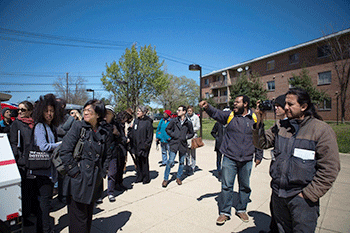
A ONE DC member conducts a tour of an apartment building in the Congress Heights neighborhood. Photo Courtesy of ONE DC.
For three consecutive years, ONE DC and George Washington University have come together to examine and respond to the various trajectories of uneven development that have framed and in all too many cases limited life chances for many of the long term residents of Washington, D.C. and the nation’s metropolitan areas generally. This year’s conference, which took place on April 5, was titled, “A Moment or a Movement: Why Black Lives Matter on the Path to Equitable Development in Washington D.C.,” and signified the centrality of race in equitable development discussions.
ONE DC is a membership-led organization in the District’s Shaw neighborhood that is fighting resident displacement by utilizing strategies where, “those directly affected by the issues make decisions related to the campaign or movement; minimize hierarchy within their organization to maximize shared power and equity of voice; and utilize direct action as an effective means to compel decision makers to implement decisions made by the community.” George Washington University is a traditional private university, but one that is increasingly engaged with various segments of the D.C. community of which it is a part.
In the opening keynote interview, renowned labor activist and scholar Bill Fletcher reminded the audience how global investment practices created “dead cities” (e.g. East St. Louis, Camden) and dying neighborhoods within cities around the nation.
There were some heated debates. Some participants called for a strong workers movement as key to equitable development, observing that poor and working class African Americans do not always have the same interests as professionals and middle class African Americans, some of whom are gentrifiers themselves, and partners in local corporate growth coalitions—the response to which, by others, was that such an approach was unnecessarily divisive.
Other participants noted that while white lives have long been valued, this was not the case with people of color, as recent filmed police shootings reaffirmed (in response, an elderly black woman and longtime activist emphasized that “all lives matter,” to the surprise of many).
A unifying theme, however, was that the status quo simply was not working for the majority of residents of D.C. and other large cities. The spirit of the Occupy movement clearly hung in the air, as many explicitly called for a right to the city for groups that had long been dispossessed. All agreed that a more collective, democratic approach to community wealth building—not just upward mobility for a few, was the overriding goal.
The housing tours were illustrative, and demonstrated equitable development resulting primarily from ONE DC’s varied organizing initiatives in action. They included:
-
- Three apartment complexes where tenant organizing preserved 192 units of affordable housing and a commercial development where a community benefits agreement created jobs and affordable housing for local residents in the rapidly gentrifying Shaw neighborhood in Northwest D.C.;
- An apartment in a Southeast neighborhood called Congress Heights, where tenants will use their right of first refusal to preserve 64 units of affordable housing and where 150 more affordable units are being planned;
- A Black Workers Center in Anacostia which serves as a business incubator for worker cooperatives, collectives, and other black-owned small businesses;
- A low-cost housing cooperative in the quickly gentrifying 14th Street NW neighborhood, which demonstrates how residents and organizers are utilizing joint ownership and shared resources to provide sustainable, affordable housing.
These are small steps in a city where hyper segregation and economic inequity remain facts of life, but they foreshadow the outlines of a new city. We’re already planning the tours for next year’s conference.





Comments